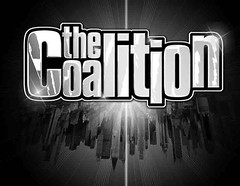« Stupid is as stupid does, but this is so much worse than that | Home | Wednesday Weekly Webcast »
Changing the Odds: Harlem Children’s Zone Project
By Jeremy | January 8, 2008
 Hollywood loves against all odds success stories. But if Harlem Children's Zone founder and CEO Geoffrey Canada has his way, Central Harlem won't be providing any more of those plot-lines in the future.
In inner cities where overcoming the odds is the only way for children to achieve success, Canada contends that the odds need to be changed. This conviction, coupled with a waiting list for the after school and summer youth programs Canada directed through the mid-1990s, convinced him to scrap a model social services organization in favor of what the New York Times Magazine calls, "one of the greatest social experiments of our time."
Hollywood loves against all odds success stories. But if Harlem Children's Zone founder and CEO Geoffrey Canada has his way, Central Harlem won't be providing any more of those plot-lines in the future.
In inner cities where overcoming the odds is the only way for children to achieve success, Canada contends that the odds need to be changed. This conviction, coupled with a waiting list for the after school and summer youth programs Canada directed through the mid-1990s, convinced him to scrap a model social services organization in favor of what the New York Times Magazine calls, "one of the greatest social experiments of our time."
The Great Experiment
Founded in 1997 as a corporate reorganization of the Harlem-based Rheedlen Centers, which ran various after-school, violence prevention, and summer youth programs for 500 children with a $3 million annual budget, Harlem Children's Zone has embraced a mission to prove that poor children, especially poor black children, can succeed in big numbers. Success means good reading scores, grades, and graduation rates for average students, not just the smartest or most motivated or the ones with engaged parents. The catalyst for Canada's changed approach was a perpetual waiting list at Rheedlen. Canada became dissatisfied that no matter how many children his centers served, their services merely treated symptoms of far deeper social ills for hundreds of children while thousands went unattended everyday. He was also frustrated with an "apartheid" type of school district where kids living below 96th Street were super achievers and kids above 96th Street chronically underperformed. Grappling with the disparity, he wondered whether it's even possible to transform the system so that success might become the norm for Harlem too. Fueled by the belief that individual children will do better if the children around them are doing better, Canada set out to prove that success can indeed become normalized. Unapologetically, HCZ is a social experiment designed to amass evidence that demonstrate how to equalize the playing field so that poor children perform on the same level as middle-class children. Canada foresees a day when, "This isn't an abstract conversation anymore. If you want poor children to do as well as middle-class children," to become "typical Americans" who can compete for jobs, "we now know how to do it."
According to the Times Magazine, "If [Canada is] right, the services he will provide will cost about $1,400 a year per student, on top of existing public-school funds. The country will finally know what the real price tag is for poor children to succeed."
In its "America's Greatest Leaders" issue (October 13, 2005), US News and World Report describes Canada as, "a brainy, driven leader with crossover appeal. ... He's got the street walk and Harvard talk." That combination generates enough credibility to be given a legitimate shot at making his experiment work.
Fueled by the belief that individual children will do better if the children around them are doing better, Canada set out to prove that success can indeed become normalized. Unapologetically, HCZ is a social experiment designed to amass evidence that demonstrate how to equalize the playing field so that poor children perform on the same level as middle-class children. Canada foresees a day when, "This isn't an abstract conversation anymore. If you want poor children to do as well as middle-class children," to become "typical Americans" who can compete for jobs, "we now know how to do it."
According to the Times Magazine, "If [Canada is] right, the services he will provide will cost about $1,400 a year per student, on top of existing public-school funds. The country will finally know what the real price tag is for poor children to succeed."
In its "America's Greatest Leaders" issue (October 13, 2005), US News and World Report describes Canada as, "a brainy, driven leader with crossover appeal. ... He's got the street walk and Harvard talk." That combination generates enough credibility to be given a legitimate shot at making his experiment work.
Holistic Programming, Tightly Networked
Canada's political philosophy is both conservative and liberal, meaning he believes the economy systematically disfavors poor people no matter how hard they work, but he also believe poor parents need to raise their children better. His solution is a holistic program paradigm that invests in traditional services such as public schools, day care, and after-school programs to remedy structural inequities, while also teaching parenting and life skills to enhance personal responsibility. None of the Zone's programs, by themselves, is unique. What is unique is how they create an interlocking web of services designed to nurture poor children in a particular neighborhood from birth through college. The Cleveland Plain Dealer describes HCZ's distinctive this way: "The Zone is a network of tightly connected initiatives. ... What sets them apart is the unifying vision Canada has imposed, creating a single, womb-through-college cocoon for thousands of poor kids ... and fierce determination to achieve measurable outcomes." Each individual initiative fits into an expansive strategy that meets different needs differently. There's no one right, cookie cutter formulation for what every individual child needs. Instead, HCZ offers a panoply of services, including: + Harlem Gems, a computer based pre-kindergarten program teaching Hooked on Phonics + Employment and Technology Center + Investment Club co-sponsored by Lehman Brothers + TRUCE after-school program for teens + Family Support Center and foster care alternatives + Baby College co-ed class for pregnant parents + Promise Academy charter school For a complete list of HCZ programs and descriptions, see Appendix A.Geographically Localized
All of HCZ's programs are geographically located within a 100 block area of Central Harlem, a neighborhood characterized by a poverty rate of nearly 50 percent and foster care placement rates among the City's highest. The 10,000 children living within this community Canada describes as "my kids," and his goal for them is, "fairness ... just give my kids a fair shot." Once they have completed college, "they're as equal as anybody else, and they'll be able to fend for themselves." The Zone's boundaries have grown since its inception as a result of a deliberate growth strategy, from an initial 24-block area to the current 100 blocks. In 2007, HCZ's web of services touched more than 7,400 children and nearly 4,300 adults in the community, exceeding its annual goal by 40%, with a budget of nearly $60 million.Four Pillars
HCZ rests its various program initiatives on four pillars. 1) Rebuild the community from within by developing indigenous leaders who already live in the neighborhood. "Mostly we found that to change a block, you had to get between 10 and 20 percent of the people engaged." Hope spreads and negative elements move elsewhere. 2) Start early and never stop. Provide services from before birth through prenatal parenting classes and continuing through the completion of college. "Our theory is you never let the kids get behind in the first place." 3) Think and plan big. Overwhelm the negative with positive influences. Make success and hard work normative. 4) Evaluate relentlessly. HCZ holds 1,300 full and part-time employees accountable to predetermined results. "If you took a salary to deliver an outcome and you didn't deliver the outcome, you can't stay here in the organization." All programs have ten-year business plans with goals, targets, and timetables.Measurable Results
Canada asks no less than 15 years from stakeholders to demonstrate that HCZ's approach actually works, calling quick fixes to entrenched social problems "pipe dreams." In exchange, he promises a rigorous reporting and evaluation methodology to track progress and identify program weaknesses. His management style runs the non-profit like a business and treats philanthropists like venture capitalists. The HCZ business plan focuses on business-oriented ideas like "market-penetration targets" and "new information technology applications" and a "performance-tracking system." The Zone regards clients as "customers" and outreach as "marketing." Administrative staff wears suits; every meeting starts on time; and reports, budgets, and evaluations flow constantly. HCZ focuses its energies and resources on what it can control -- namely excellent supportive services for children -- and not issues beyond their control such as adult marriages and underemployment. Then it recruits relentlessly to register its target market -- the most "at-risk" youths in the neighborhood -- through door knocking, fliers, sign-ups, raffles, prizes, and give-a-ways (even "bribes"); and promises to deliver excellent results. For example, HCZ called its first charter school Promise Academy because, "We are making a promise to all of our parents. If your child is in our school, we will guarantee that child succeeds. There will be no excuses. ... If you work with us as parents, we are going to do everything -- and I mean everything -- to see that your child gets a good education."
HCZ's educational philosophy emphasizes both testing and accountability. They work within the existing public school system while simultaneously opting-out by starting two charter schools. HCZ's charter schools operate a longer school day, from 8 am - 4 pm, with supplementary after-school programs until 6 pm; and their academic years extend into July. HCZ has met resistance from the Teachers Union because, even though charter school teachers get paid more than union teachers, they work longer hours, a full 12 months a year, and without the possibility of tenure.
HCZ focuses its energies and resources on what it can control -- namely excellent supportive services for children -- and not issues beyond their control such as adult marriages and underemployment. Then it recruits relentlessly to register its target market -- the most "at-risk" youths in the neighborhood -- through door knocking, fliers, sign-ups, raffles, prizes, and give-a-ways (even "bribes"); and promises to deliver excellent results. For example, HCZ called its first charter school Promise Academy because, "We are making a promise to all of our parents. If your child is in our school, we will guarantee that child succeeds. There will be no excuses. ... If you work with us as parents, we are going to do everything -- and I mean everything -- to see that your child gets a good education."
HCZ's educational philosophy emphasizes both testing and accountability. They work within the existing public school system while simultaneously opting-out by starting two charter schools. HCZ's charter schools operate a longer school day, from 8 am - 4 pm, with supplementary after-school programs until 6 pm; and their academic years extend into July. HCZ has met resistance from the Teachers Union because, even though charter school teachers get paid more than union teachers, they work longer hours, a full 12 months a year, and without the possibility of tenure.
Community Partnerships
The Zone supplements its own service offerings by partnering with parents, residents, teachers and other community stakeholders to create a safe, nurturing environment that extends beyond its programs. By collaborating with churches, parks, local businesses and schools, HCZ advocates for education reform, economic development, and crime reductions while proactively rebuilding the neighborhood.The Challenge of Fatherlessness
 The issue of fatherlessness is deeply personal for Canada, both as a central subplot in his own "against the odds" story and as a driving factor in the culture the Zone seeks to overcome. Canada tackles the subject specifically in one of his books, Reaching up for Manhood: Transforming the Lives of Boys in America
The issue of fatherlessness is deeply personal for Canada, both as a central subplot in his own "against the odds" story and as a driving factor in the culture the Zone seeks to overcome. Canada tackles the subject specifically in one of his books, Reaching up for Manhood: Transforming the Lives of Boys in AmericaChallenges to Replication
Canada identifies three main challenges to replicating the Harlem Children's Zone model in other communities. The first, and most fundamental, is finding the right leadership. An appropriate leader is someone whom the community and donors are going to hold accountable while giving that person the authority to hold others accountable. "This won't work with a collaborative of equal partners." Second is the discipline and resolve to stay true to the four pillars, including: empowering indigenous leadership to own the transformation process; embracing large and scalable strategies; adopting a long-term, comprehensive, birth through college service commitment; and evaluating and improving performance constantly. Last is mobilizing and sustaining the commitment of staff, volunteers, community stakeholders, funders, and residents.Sources
+ Harlem Children's Zone website: www.hcz.org + Sam Fulwood III, Bob Paynter and Sandra Livingston, "Central Harlem program combines leadership, commitment to rebuild a community," Cleveland Plain Dealer (December 13, 2007) + Chester Higgins, Jr., "Vision," New York Times (June 7, 2006) + Anderson Cooper, "Stop Snitching," 60 Minutes (April 22, 2007) + Deborah A. Pines, "America's Best Leaders: Thriving in the Zone," US News and World Report (October 31, 2005) + Paul Tough, "The Harlem Project," New York Times Magazine (June 20, 2004) + Transcript, "Moving Toward Manhood," The News Hour with Jim Lehrer (January 20, 1998) + Felicia Lee, "Being a Man And a Father Is Being There," New York Times (June 18, 1995)Topics: case studies, community development, fatherlessness, geoffrey canada, harlem children's zone, mentoring, research, youth development, youth ministry | 1 Comment »

 Welcome to the professional website and personal weblog of Jeremy Del Rio. Whether you're a client, friend, or curious onlooker, please don't stay a spectator. Engage the conversation. Your contributions matter here.
Welcome to the professional website and personal weblog of Jeremy Del Rio. Whether you're a client, friend, or curious onlooker, please don't stay a spectator. Engage the conversation. Your contributions matter here.


















February 4th, 2008 at 8:34 pm
I WOULD LIKE TO KNOW IF YOU HAVE A CHANGING THE ODDS ORGANIZATION IN CHICAGO